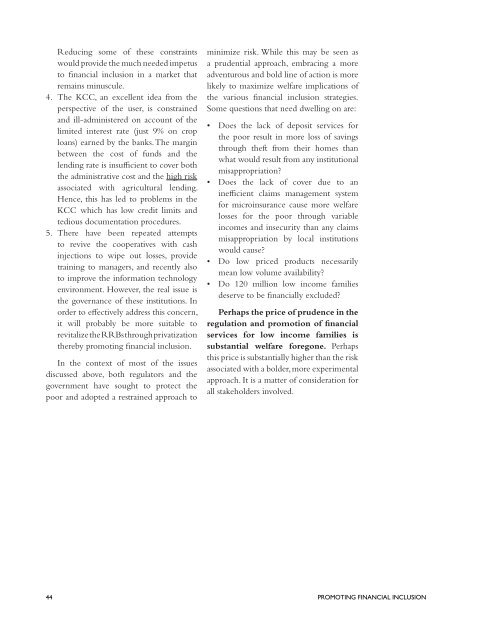Promoting Financial Inclusion - United Nations Development ...
Promoting Financial Inclusion - United Nations Development ...
Promoting Financial Inclusion - United Nations Development ...
You also want an ePaper? Increase the reach of your titles
YUMPU automatically turns print PDFs into web optimized ePapers that Google loves.
Reducing some of these constraints<br />
would provide the much needed impetus<br />
to financial inclusion in a market that<br />
remains minuscule.<br />
4. The KCC, an excellent idea from the<br />
perspective of the user, is constrained<br />
and ill-administered on account of the<br />
limited interest rate (just 9% on crop<br />
loans) earned by the banks. The margin<br />
between the cost of funds and the<br />
lending rate is insufficient to cover both<br />
the administrative cost and the high risk<br />
associated with agricultural lending.<br />
Hence, this has led to problems in the<br />
KCC which has low credit limits and<br />
tedious documentation procedures.<br />
5. There have been repeated attempts<br />
to revive the cooperatives with cash<br />
injections to wipe out losses, provide<br />
training to managers, and recently also<br />
to improve the information technology<br />
environment. However, the real issue is<br />
the governance of these institutions. In<br />
order to effectively address this concern,<br />
it will probably be more suitable to<br />
revitalize the RRBs through privatization<br />
thereby promoting financial inclusion.<br />
In the context of most of the issues<br />
discussed above, both regulators and the<br />
government have sought to protect the<br />
poor and adopted a restrained approach to<br />
minimize risk. While this may be seen as<br />
a prudential approach, embracing a more<br />
adventurous and bold line of action is more<br />
likely to maximize welfare implications of<br />
the various financial inclusion strategies.<br />
Some questions that need dwelling on are:<br />
• Does the lack of deposit services for<br />
the poor result in more loss of savings<br />
through theft from their homes than<br />
what would result from any institutional<br />
misappropriation?<br />
• Does the lack of cover due to an<br />
inefficient claims management system<br />
for microinsurance cause more welfare<br />
losses for the poor through variable<br />
incomes and insecurity than any claims<br />
misappropriation by local institutions<br />
would cause?<br />
• Do low priced products necessarily<br />
mean low volume availability?<br />
• Do 120 million low income families<br />
deserve to be financially excluded?<br />
Perhaps the price of prudence in the<br />
regulation and promotion of financial<br />
services for low income families is<br />
substantial welfare foregone. Perhaps<br />
this price is substantially higher than the risk<br />
associated with a bolder, more experimental<br />
approach. It is a matter of consideration for<br />
all stakeholders involved.<br />
44 PROMOTING FINANCIAL INCLUSION

















